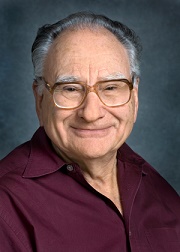
Arthur M. Poskanzer
Distinguished Senior Scientist, Emeritus
Lawrence Berkeley National Laboratory
Art Poskanzer, Distinguished Senior Scientist Emeritus in the Nuclear Science Division at LBNL, died peacefully at home on June 30, 2021, after a long illness, two days after his 90th birthday.
Art was born in New York City. He was sickly as a young child, and was kept at home until 6th grade. He later became a Boy Scout and Eagle Scout, with a love of hiking, biking, and climbing mountains. The gift of a chemistry set began his early love of science. He graduated from Stuyvesant High School in New York in 1949 and attended Harvard as an undergrad, graduating with honors in 1953 with a joint degree in chemistry and physics. He received a Master's degree from Columbia University in 1954, and a Ph.D. in physical chemistry from MIT in 1957. His Ph.D. thesis utilized radioactive tracers to study solvent extraction; his advisor was Charles Coryell, a competitor of Glenn Seaborg in Berkeley.
Art was an outstanding scientist, who maintained an active research career for over sixty years. He began his professional career as a nuclear chemist at Brookhaven National Laboratory, carrying out the first computer simulations of proton interactions in nuclei in the late 1950s. He moved to Lawrence Radiation Laboratory in 1966 to join Earl Hyde’s group, later the Poskanzer-Hyde group, in the Nuclear Chemistry Division. He was one of the first users of the Bevatron for nuclear physics, discovering many neutron-rich isotopes of light nuclei. When nuclear beams were introduced in the Bevatron, converting it into the Bevalac, Art formed an international collaboration with Rudolf Bock and Reinhard Stock from Germany to exploit the new facility. In the first years of Bevalac operation with Argon beams, they mapped out the geometry of the collisions. However, they quickly realized that more sophisticated apparatus, and heavier beams, would be needed to elucidate the reaction mechanism.
Art, together with Hans Gutbrod and Hans Georg Ritter, then developed the Plastic Ball, the first large-acceptance detector for heavy-ion physics that was used at the upgraded Bevalac to discover the collective flow of nuclear matter, which still today is an essential tool for the study of nuclear matter at all energies. The Plastic Ball was then moved to CERN, and was installed at the SPS as part of their new heavy ion program. When the Relativistic Heavy Ion Collider was approved for construction in the early 1990s, Art convened a working group at Berkeley and hosted a series of seminars, to decide what kind of detector to propose. The outcome was the STAR detector, which was the only one of nine candidate RHIC detectors to be approved and built as proposed, and which continues to produce world-class physics today.
In 1980 Art won the Seaborg Award from the American Chemical Society, and in 2008 he was awarded the Bonner Prize by the American Physical Society “in recognition of his pioneering role in the experimental studies of flow in Relativistic Heavy Ion Collisions.” Art is one of very few scientists to have won both awards.
Art had a profound influence at LBNL, as scientific director of the Bevalac and as founder of the Relativistic Nuclear Collisions program in the NSD. He retired in 2002 but stayed active – for many years, his definition of retirement was not to come to the office on Wednesdays. He continued to carry out physics analyses and to collaborate widely, still producing papers and attending seminars until just a few years ago.
Art and Lucille met as students at Harvard and were married for 67 years. They loved going to restaurants, and in 1978 they started a newsletter of reviews called “Restaurants in the Berkeley Area,” which is renowned in the San Francisco Bay Area – the latest update was in 2020.
Art was mentor and friend to many scientists in the heavy ion community. He was beloved for his sharp humor, his critical eye, and his very high standards. He will be sadly missed.
Art is survived by Lucille, their children and spouses Deborah and Alan, Harold and Marjorie, and Jef, and grandchildren Felix, Leo, Frieda, and Henry.
Peter Jacobs
2021
